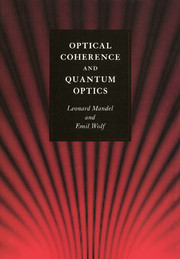Book contents
- Frontmatter
- Contents
- Preface
- 1 Elements of probability theory
- 2 Random (or stochastic) processes
- 3 Some useful mathematical techniques
- 4 Second-order coherence theory of scalar wavefields
- 5 Radiation from sources of any state of coherence
- 6 Second-order coherence theory of vector electromagnetic fields
- 7 Some applications of second-order coherence theory
- 8 Higher-order correlations in optical fields
- 9 Semiclassical theory of photoelectric detection of light
- 10 Quantization of the free electromagnetic field
- 11 Coherent states of the electromagnetic field
- 12 Quantum correlations and photon statistics
- 13 Radiation from thermal equilibrium sources
- 14 Quantum theory of photoelectric detection of light
- 15 Interaction between light and a two-level atom
- 16 Collective atomic interactions
- 17 Some general techniques for treating interacting systems
- 18 The single-mode laser
- 19 The two-mode ring laser
- 20 The linear light amplifier
- 21 Squeezed states of light
- 22 Some quantum effects in nonlinear optics
- References
- Author index
- Subject index
17 - Some general techniques for treating interacting systems
Published online by Cambridge University Press: 05 April 2013
- Frontmatter
- Contents
- Preface
- 1 Elements of probability theory
- 2 Random (or stochastic) processes
- 3 Some useful mathematical techniques
- 4 Second-order coherence theory of scalar wavefields
- 5 Radiation from sources of any state of coherence
- 6 Second-order coherence theory of vector electromagnetic fields
- 7 Some applications of second-order coherence theory
- 8 Higher-order correlations in optical fields
- 9 Semiclassical theory of photoelectric detection of light
- 10 Quantization of the free electromagnetic field
- 11 Coherent states of the electromagnetic field
- 12 Quantum correlations and photon statistics
- 13 Radiation from thermal equilibrium sources
- 14 Quantum theory of photoelectric detection of light
- 15 Interaction between light and a two-level atom
- 16 Collective atomic interactions
- 17 Some general techniques for treating interacting systems
- 18 The single-mode laser
- 19 The two-mode ring laser
- 20 The linear light amplifier
- 21 Squeezed states of light
- 22 Some quantum effects in nonlinear optics
- References
- Author index
- Subject index
Summary
In the preceding chapters we have solved a number of specific problems in which electromagnetic fields interact with charges, atoms, or molecules, and these have been approached in several different ways. For example, for the problem of photoelectric detection, which involves short interaction times, we found it convenient to use a perturbative method, whereas the resonance fluorescence problem was treated by solving the Heisenberg equations of motion. In the following sections we shall encounter a number of general methods for tackling interaction problems that can often simplify the problems substantially when they are applicable. We shall illustrate the utility of these methods by recalculating a number of results that were obtained in a different manner before.
The quantum regression theorem
It was shown by Lax (1963; see also Louisell, 1973, Sec. 6.6) that, with the help of a certain factorization assumption, it is often possible to express multi-time correlation functions of certain quantum mechanical operators in terms of single-time expectations. The result is now known as the regression theorem. As multi-time correlation functions play a rather important role in quantum optics, the theorem is often of great utility, and it can drastically simplify certain calculations. In the following we largely adopt the procedure given by Lax.
We consider two coupled quantum systems, to which, for the sake of convenience, we shall refer as the system (S) and the reservoir (R).
Information
- Type
- Chapter
- Information
- Optical Coherence and Quantum Optics , pp. 860 - 899Publisher: Cambridge University PressPrint publication year: 1995
Accessibility standard: Unknown
Why this information is here
This section outlines the accessibility features of this content - including support for screen readers, full keyboard navigation and high-contrast display options. This may not be relevant for you.Accessibility Information
- 1
- Cited by
